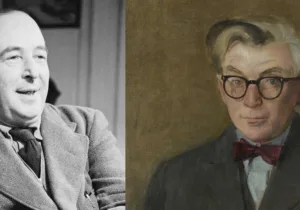Armenia was the first nation to adopt Christianity as the state religion in 301 CE. This act was the precursor to the development of a distinct Armenian ethos separate from its neighbors, primarily Iran. It ultimately led to the invention of the Armenian alphabet in 405 CE, which was integral to the emergence and cultivation of the Armenian ethno-religious identity.
Following the partition of Armenia in 387 CE, the Armenian realm was rent in twain. A political interregnum followed and subsequently acted as the impetus toward pioneering the notion for a need of an Armenian alphabet. A nationalized religion and a distinct alphabet would effectively act as a tool to unify the Armenians living in the Byzantine Empire and Sassanid Iran, in addition to upholding the essence of what it meant to be Armenian.
Prior to the fifth century, Armenians used Greek for artistic and cultural expressions, Latin and Middle Persian for official communication and inscription, and Syriac for liturgical purposes. During the interregnum, when national unity was compromised, St. Sahak Partev Catholicos realized that in order to retain any ecclesiastical and political control over a partitioned nation, the unifying nature of the Armenian language would be crucial. Under the patronage of the Catholicos, St. Mesrop Mashtots was tasked with inventing the Armenian alphabet.
According to Mashtots’s Armenian biographers, he consulted Daniel, a Mesopotamian bishop, and Rufinus, a Samosatan monk, on the invention of the Armenian script. Through these endeavors, Mashtots was able to provide a definitive form of the alphabet, modeling it largely from the Greek script, according to consensus. The Greek-like ordering of the Armenian alphabet was supplemented by letters and sounds from different sources, presumably Syriac.
Mashtots’s massive undertaking can be understood when examining his disciple Koryun’s narratives. An itinerant preacher educated amongst the ecclesiastical ranks, Mashtots embraced his holy orders through lamentation and tears, in hunger and thirst, in confinement and solitude, and in deep prayer and meditation. While the Armenian saint was gifted in the mnemonic arts, seasoned by his education and command of Greek and Syriac, the invention of the Armenian alphabet was initiated after an apparition of emotional aporia. According to the Father of Armenian History, Movses of Chorene, what followed was “the subconscious-ordering of the entire, new alphabet at once: not in a vision or a dream, but as a right hand inscribing the letters on stone, seen by the eyes of the soul.”
Apart from the patronage from the Armenian Church, it is impossible to ignore the Christian undertones of the Armenian alphabet. The Armenian alphabet exhibits an alpha and omega-like sequence where it begins with God and ends with God. The first letter “Ա” stands for Astvats, and the last letter “Ք” stands for Christos, the Armenian words for God and Christ, respectively. The final letter is undoubtedly a stylized form of the Chi-Rho, which is the abbreviation of the name of Christ and the Cross. Greeted as a divine gift and opening with Astvats, a reference to God, “The nature of logos flows forth from thee, giving us to drink the milk of wisdom,” writes St. Nerses Shnorhali, the twelfth-century Armenian catholicos and famed theologian. The Ք, by its Christ-like shape, encourages us to take up His Cross, adds St. Nerses Shnorhali. The letters with which one would write the Word of God must be God-given, and hence the characterization of the Armenian alphabet was classified as divine.
In a threatening environment, St. Mesrop Mashtots armed the Armenian language with an alphabet. Subsequently, a team of translators began to systematically translate most works of Greek and Syriac literature, of utmost importance being the Bible. The first to be translated to the Armenian language was the maxim unearthed in Proverbs 1:2: “To know wisdom and instruction, to perceive the words of understanding.”
The Bible was thus the first text to be translated and baptized as the “Breath of God.” An era of flourishing literature followed, paving the way for Armenia’s Golden Age a century later. The invention of the Armenian alphabet ushered in a century of many achievements, including the resurgence of education and a flux of Armenian students relocating to renowned centers of higher learning, such as Alexandria, Antioch, Athens, Caesarea, Constantinople, Edessa, and Rome, resulting in their respective contributions to both translated and original literature.
The efforts of the aforementioned included procuring codices in Greek and Syriac, translating them and initiating the curation of the ancient corpus of ecclesiastical literature into the Armenian realm. This new Armenian literati was responsible for the evolution of Armenian liturgy and history. The emergence of Armenian translators, historians, and intelligentsia followed, such as Agathangelos, who composed the History of the Armenians detailing Armenia’s conversion to Christianity; David the Invincible, who rose to become Armenia’s greatest orator; Faustus of Byzantium, who authored another History of the Armenians recounting fourth-century Armenian life; Hovhannes Mandakouni, who established the order of the liturgy; Koryun, who wrote the biography The Life of Mashtots; Lazar of Parpi, who authored a history of Armenia from where Faustus of Byzantium left off; Movses of Chorene, who recorded the substantive and exhaustive History of Armenia until the fifth century; Yeghishe, who penned the History of Vartan and the Armenian War; Yeznik of Kolb, who wrote countless religious treatises; and others. Many of the translated works have since been lost in their Greek or Syriac original, but have been preserved in the Armenian, a testament to the industrious efforts of the Holy Translators.
In consolidating Armenian identity, conversion includes proselytization and evangelism, whereas Christianization can be described as a cultural process, perpetuating an agency in the reshaping, reimagining, and remaking of culture. This Christianization for Armenia necessitated the creation of a script in what became the bearer of literary culture and a distinct ethno-religious identity. The advent of this alphabet and its rapid spread allowed for the Armenian people to preserve their teachings and traditions. The 36-letter alphabet (two more were added in the eleventh and twelfth centuries), created by St. Mesrop Mashtots, became so well-suited to the sounds of the Armenian language that it has served its purpose for over sixteen hundred years. The invention of an Armenian script untethered the intellectual and spiritual potential of an entire people, assisting in the cultivation of Armenian culture and preventing it from any susceptibility to amnesia.






